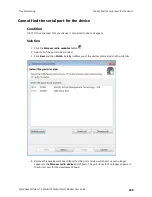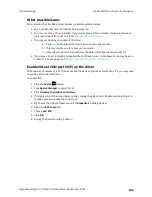
Troubleshooting
Hardware flow control in Bypass mode
Digi XBee3 Cellular LTE-M/NB-IoT Global Smart Modem User Guide
244
of the product label.
Hardware flow control in Bypass mode
The lack of hardware flow control support in the u-blox SARA-R410M-02B cellular component may
impact the reliability of Bypass mode. Per section 2.5.1
UART interface
of the SARA-R4 datasheet:
Hardware flow control is not supported by the “00”, “01” and “02” product versions
While the XBee Smart Modem does support hardware flow control on the external UART (pins 2, 3, 12
and 16) the internal UART connection to the cellular component does not. RTS/DIO6 and CTS/DIO7
reflect the flow control state of the device's internal buffers, not the flow control state of the cellular
component. This may lead to data loss while in Bypass operating mode during periods of high UART
traffic.
The configuration command
does not control the baud rate of this internal UART
connection. The XBee Smart Modem does not currently have an option to change the baud rate of the
internal UART connection to match any changes to the
AT
+
IPR
setting of the cellular component. We
suggest that customers interested in Bypass mode consider using direct USB mode.
Socket leaks
This applies to devices with the u-blox SARA-R410 cellular component used in the XBee3 Cellular LTE-M
Global Smart Modem.
Condition
There are instances where a socket leaks when closing a connection while there is pending RX data.
This state is reported whenever the number of leaked sockets causes an inability to create a new
connection.
For Transparent and API modes the XBee Smart Modem returns specific status responses to describe
that you need to perform a hard reset to recover the leaked sockets. These statuses are:
Mode
Response
Transparent
mode
CI (Protocol/Connection Indication)
reports
0x13
Socket leak









































